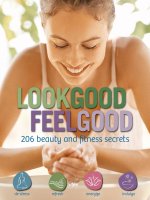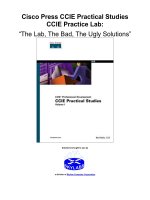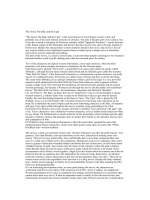The Good, the Bad, and the Ugly - Winning and Losing Essays
Bạn đang xem bản rút gọn của tài liệu. Xem và tải ngay bản đầy đủ của tài liệu tại đây (155.12 KB, 18 trang )
chapter
in
Chapter Four, you completed a
variety of 1-2-3 Maps and essays for
each kind of writing. But the question
is: Do the essays demonstrate writing
proficiency and to what extent? Another
way of putting it is: Are they good, bad, or
ugly?
You need some constructive feed-
back that starts with a self-assessment of
your own writing skills. Understanding
the rubrics introduced in Chapter Two
will help you. They are Idea and
Content; Organization;Voice;Word Choice;
Sentence Fluency; Conventions/Mechanics.
In this chapter you will learn about
rubrics—the rules and essential princi-
the good, the bad, and the ugly
67
five
The Good,
the Bad,
and the Ugly:
Winning and
Losing Essays
ples of good writing. You will learn to work with rubrics, so that they can
work for you when you write; you will understand each rubric in general and
how they relate to your writing in particular. And you will understand how
and why visual writing helps you with all the aspects of good writing, not just
organization.
In other words this chapter makes you ready: essay test ready!
organization: the name of the writing game
W
HETHER YOU LIVE
in Bangor, Maine, or Honolulu, Hawaii, rubrics are
the rules that are used to determine or assess your grade in writing. While
the terminology of rubrics may vary slightly depending on where you live,
organization, the first of six rubrics we will explore, is the most important.
Read the following objective for writing assessment from the National
Assessment of Educational Progress, NAEP, the people who oversee the most
notable writing assessment tests in our country, as well as publish The Nation’s
Report Card:
Students should display effective choices in the organization of
their writing. They should include details to illustrate and elaborate
their ideas, and use appropriate conventions of written English.*
With its emphasis on organization, this quote clearly illustrates how your
writing success is almost guaranteed when you rely on the principles of visu-
al writing that guide your essay’s organization.
organization rules!
Y
OU WILL LEARN
and understand rubrics by using them. Let’s examine the
two essay samples from the previous chapter whose topic was the nutrition-
al value of a cereal breakfast. Remember: Each student worked from the
same hierarchical map.
*Writing Framework and Specifications for the 1998 National Assessment of Educational
Progress, p. 27.
visual
writing
68
1-2-3 maps and organization
Here are essential characteristics or traits that define the term organization on
most rubrics:
■
inviting introduction
■
thoughtful transitions
■
logical, effective sequencing
■
controlled pacing
■
smooth flow throughout text
■
satisfying conclusion
student sample 1
“the breakfast of champions”
How do you choose your breakfast foods? Do you want convenience,
and so you choose a Pop-Tart
®
kind of food? Or do you want nutri-
tion and therefore choose a cereal breakfast? That’s what I do, and I do
it for three reasons: Carbohydrates, vitamins, minerals, and protein.
Cereal is a major source of carbohydrates. By the time you reach
junior high school, you know that carbohydrates provide the body
with the energy it needs to function. Our bodies do not do any-
thing without carbohydrates. Thinking, running, writing, and
everything else the body does requires energy, and cereal provides it.
If you take a look at the side of any cereal box, you will see a
breakdown of its vitamins and minerals. There are a lot of them too,
and they are all good for your body. But the best mineral a cereal
breakfast contains is calcium. That’s because of the milk you add to
your cereal. You don’t eat it dry, do you? How often have you been
reminded by your parents to drink your milk? It’s good for your
bones. Well they’re right. As teenagers, we need to remember our
bones; they’re still growing. If we don’t supply them with foods like
milk, then we risk breaking our bones or not developing them
properly. Most of us drink Coke or Pepsi during the day, so it just
makes sense to add milk to your cereal so you get your calcium.
the good, the bad, and the ugly
69
Besides calcium, the milk you pour on your cereal is also a good
protein source. The cereal has a little protein too, but the milk has
more. Protein is an essential nutrient that maintains, repairs, and
builds our muscles. It’s even good for our blood.
By now you know about the nutritional benefits a cereal break-
fast supplies. It will start your day off right with a blast of energy.
Cereal gives you strong bones. When you eat it with milk you get
calcium in addition to all the vitamins and minerals that the cereal
and milk have for your body. And finally, a cereal breakfast helps
your muscles stay fit because of its protein. There you have it.
Cereal really is the “breakfast of champions.”
the verdict for sample 1
1. Inviting Introduction
The writer invited the reader into her essay
with questions before she identified her topic:
“How do you choose your breakfast foods? Do you
want convenience and so you choose a Pop-Tart
®
kind of food? Or do you want nutrition and therefore
choose a cereal breakfast?” The writer skillfully
answered her own questions, using the subconcepts laid
out in her hierarchical chart: “Carbohydrates, vitamins and minerals, and protein.”
Using topic cues from the box section of her 1-2-3 map as her guide, she
introduces her objective, her thesis statement about the nutrition found in
cereal, and invites the reader into her essay.
2. Thoughtful Transition/Logical/Effective
Sequencing/Controlled Pacing/Smooth
Flow Throughout Text
You can readily see how this writer used the
details from her hierarchical chart, the middle
section of her 1-2-3 map. As a result, her essay
measures up to the rubric traits that expect sequenc-
visual
writing
70
ing to be logical and effective. She carries the logic of her chart into her writ-
ing and connects the details with style, helping her sentences and paragraphs
flow effectively, from one to another.
3. Satisfying Conclusion
The ending is satisfying. “There
you have it. Cereal really is the
breakfast of champions.” The
writer used the last section of her 1-
2-3 map to remind herself that an essay
restates the purpose. Rather than a blunt restatement, the writer uses what
she knows about good writing, crafting a satisfying conclusion by quoting a
popular cereal slogan.
student sample 2:
“cereal”
Cereal is a very nutritious food. When you add milk to it, it’s an
excellent source of many nutrients. I will discuss the nutrients in a
corn flakes and milk breakfast. They are carbohydrates, vitamins,
minerals, and protein. Milk provides protein, which builds our
muscles. Cereal has some protein but not as much as milk.
Crabohydrates are important because they give our bodies energy.
Vitamins and minerals are important because they maintain all our
bodies’ functions. Calcium, which is a mineral found in milk, is
very important for strong bones.
1. Inviting Introduction—NO!
If this essay were on trial, its defense would not be strong enough to win
the case! In a most boring fashion, this writer merely tells the reader that
cereal is nutritious. Rather than apply the words in the box of the 1-2-3
map as a guide, he merely recopied them: “I will discuss the nutrients in a corn
flakes and milk breakfast.They are carbohydrates,...”
the good, the bad, and the ugly
71
2. Thoughtful Transition/Sequencing-Logical/Effective Pacing
Controlled/Flows Smoothly
Not one of these four traits for organization is evident. This essay begs the
question: Why construct a graphic organizer and a 1-2-3 map if you don’t
intend to follow it? The student’s statements, especially those made about
milk, are written in a very arbitrary way; information about the calcium in
milk is in the last sentence when several sentences earlier, the student
informed the reader about the protein in milk. Didn’t he remember that his
1-2-3 map was constructed to remind him that he needed to restate his
objective? It wasn’t about milk and calcium.
3. Satisfying Conclusion
Satisfying? There isn’t even a conclusion to evaluate! The writer did not
follow his 1-2-3 map and leaves his readers and his essay hanging.
use it or lose it!
I
F YOU PREPARE
graphic organizers for the topics laid out by essay prompts,
if you construct 1-2-3 maps because you understand how they remind you
of essential beginning, middle, and ending statements or paragraphs, please
use them! Visual maps are not the end; they are the means to the end. Here’s
how The Nation’s Report Card experts say it:
Students may express their ideas and organize their response in an
outline, list, word web or other means. With the time constraints
in mind, students should then move to the stage of compo-
sition, during which they draft the material in sentence and para-
graph form.*
*Writing Framework and Specifications for the 1998 National Assessment of Educational
Progress, p. 27.
visual
writing
72
plan the play and play your plan
Y
OU HAVE A
large reading audience: parents, teachers, state officials, and
national organizations like NAEP. With visual writing, you will be ready for
them all, no matter what the reason for their interest in your work.
Plan your essay’s strategy through visual writing; then, please play your
plan. Now that you’ve familiarized yourself with the rubric for organization,
you are ready to continue.
organization: the springboard of effective writing
L
ET
’
S TAKE A
different, graphic, look at the six rubrics as well as NAEP’s
writing assessment objective, whose hierarchy began with organization:
Students should displa
y effective c
hoices in the organization
of their writing. They
should include details to illustrate and elaborate their ideas, and use appropriate con-
ventions of written English:
the good, the bad, and the ugly
73









